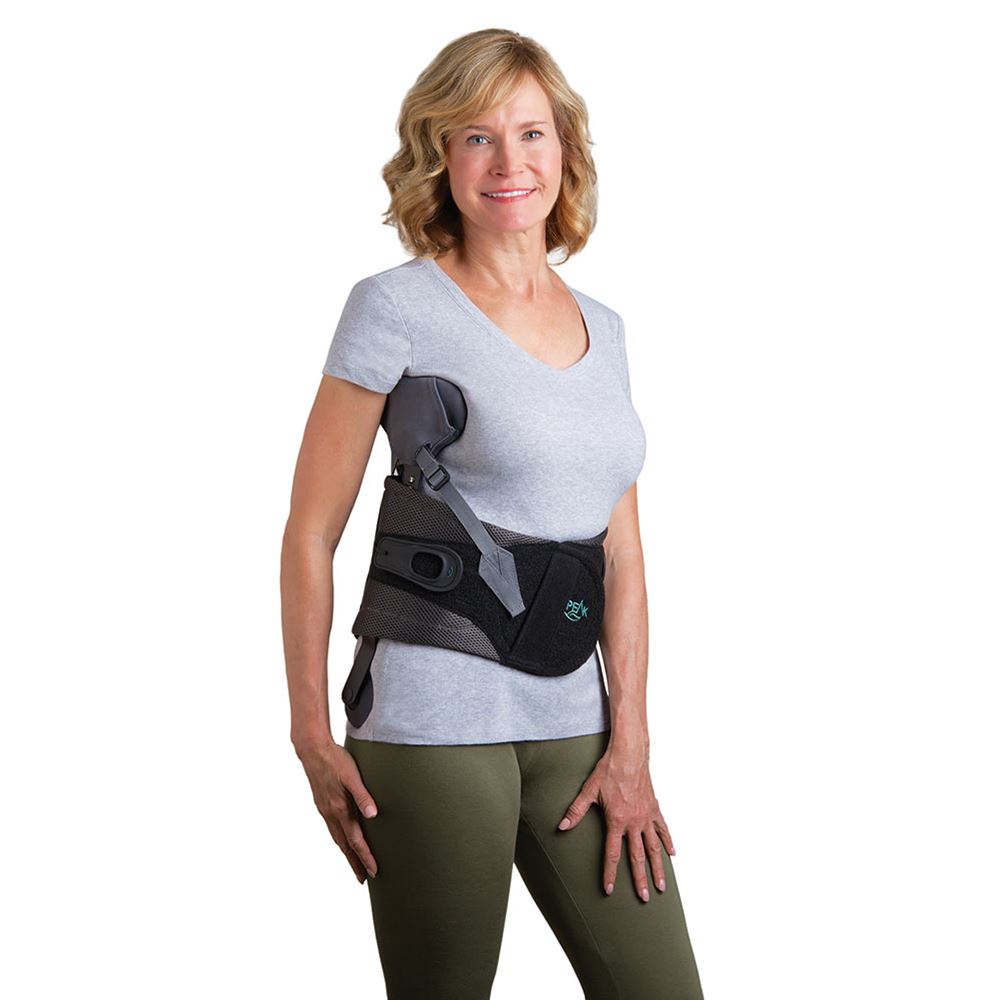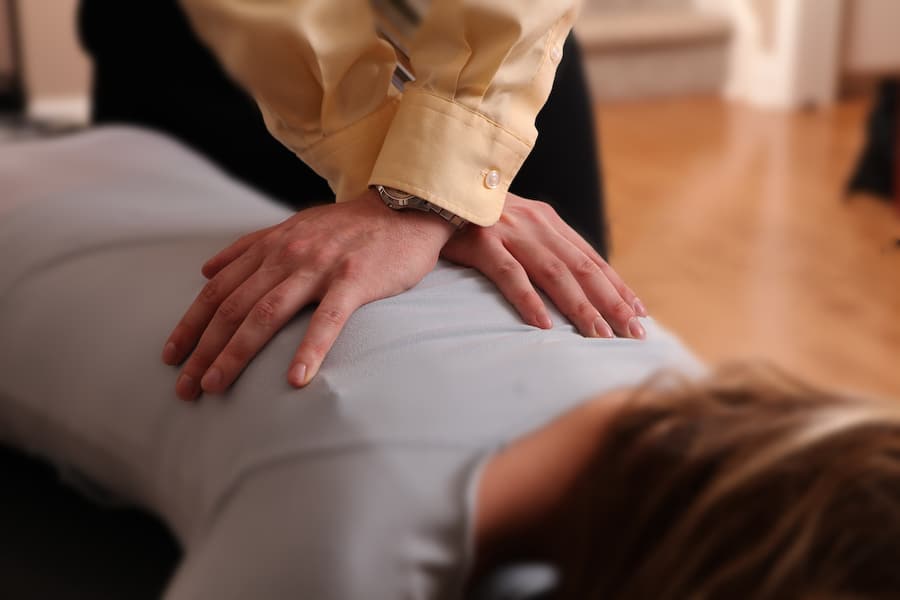The struggle is real. The pain is real. Doctor after doctor tells you scoliosis doesn't cause pain, but you body tells a different story. From head to toe, inside and out, chronic pain from scoliosis can dictate every moment and decision in your life. From the time you first notice the pain to the moment you realize the severity of the scoliosis, it can feel like an uphill battle. That's why it's important to have a good understanding of scoliosis pain relief so you can make the most of your journey. In this blog, we'll outline the signs of scoliosis and tell you what options are available for pain relief. We'll also discuss the outlook for scoliosis pain, the different treatments available, and the importance of seeking help from a specialist as soon as possible. Armed with this information, you can start making informed decisions that will help you live a pain-free life!

How is scoliosis diagnosed?
Scoliosis is a curvature of the spine, and as a result, pain can be chronic and debilitating. If you're living with scoliosis pain, here are some tips and tricks to help ease the pain and improve your quality of life. First and foremost, scoliosis is usually diagnosed by looking at X-rays of the spine. If scoliosis is suspected, other tests may be ordered to confirm the diagnosis and determine the best treatment plan for you. Treatments for scoliosis typically include exercises, bracing, surgery, and a variety of other treatments. It's important to remember that there is no one-size-fits-all treatment for scoliosis, so find the plan that works best for you and stick to it! Additionally, make sure to keep up with your treatment strategy and maintain a healthy lifestyle to help prevent scoliosis from worsening.
What is adult scoliosis?
Scoliosis is a curvature of the spine that can happen to children, adolescents, or adults. It's often diagnosed in young people, but it can persist into adulthood for many people. Adult scoliosis most commonly happens because of complex factors like hormone imbalance, bone density and gravity- which means there's currently no cure for adult scoliosis. However, there are treatments available that help improve pain and mobility.
Symptoms of scoliosis

Scoliosis is a curvature of the spine that can cause pain and stiffness. If you are experiencing any of the following symptoms, it may be scoliosis: back pain, difficulty breathing, and fatigue. Treatment for a spinal curve may involve surgery or physical therapy. It's important to keep track of your health condition so you know when treatment is necessary – don't wait until it becomes too painful to seek help! If you're experiencing pain or discomfort, don't hesitate to consult your doctor. In the meantime, try the following tips to relieve scoliosis pain:
When to see a doctor

There are a few scenarios when it is especially important to see a doctor: Adults suffering from sudden back pain, chest pain, or leg pain; and every 4-6 months for children with scoliosis. A doctor can help diagnose, monitor, and treat the underlying issues that may be causing your symptoms. If these symptoms continue to get worse, consult a physician as soon as possible!
What does scoliosis pain feel like?
Scoliosis pain can be extremely debilitating and affect the overall quality of life. It is common for people with scoliosis to experience pain in the back, sides, hips, and lower spine. There are many symptoms of scoliosis pain that may go unnoticed or untreated; it is important to be familiar with them so you can identify potential problems early on. When treating scoliosis pain, medication and/or core exercises often play a significant role. Maintaining a healthy lifestyle - including proper diet and exercise- also helps relieve scoliosis pain naturally over time.
How is scoliosis pain treated?
There is no one-size-fits-all answer to the question of how scoliosis symptoms are treated. However, the most common treatment strategies for scoliosis pain include exercises, surgery, or a combination of nutrient therapies. Depending on the severity of the case, treatments may also include scoliosis rehabilitation, surgery, or a combination of nutrient therapies. Early treatment with treatment strategies like these are critical for the long-term prognosis of scoliosis patients.
Scoliosis braces

There are a variety of non-surgical treatments that can be used to relieve pain related to scoliosis. Some examples include scoliosis exercises, natural painkillers, and a back brace. Many patients find a back brace to be very cumbersome and uncomfortable. Always consult with a doctor before starting any treatment and don't hesitate to ask about the pros and cons of each scoliosis treatment modality.
ScoliSMART Activity Suit

The energy of a person's natural movement is used to generate new muscle memory with the ScoliSMART™ Activity Suit. This new muscle memory helps the spine unwind naturally, never forced, by reducing and stabilizing asymmetrical muscle firing. The force of the ScoliSMART™ Activity Suit is resisted by the body with each step, changing the muscle's stored energy and firing sequence. The spine responds to demand in the same way that muscles do. ScoliSMART™ Activity Suit does not utilize direct pressure on the curves' peaks to force correction, unlike bracing, because forcing correction does not lead to new muscle memory.
Complementary therapies
There are a variety of complementary therapies that can be used to relieve pain from scoliosis. Some of the most popular treatments include massage or acupuncture. It is important to find a therapy that works best for your specific condition and consult with your doctor before starting any new treatment plan. Make sure you keep all records of your treatment sessions so you can track the progress over time.
Nutrient Therapies and Pain Medication

There are various types of nutrient therapies and medications that can be used to treat idiopathic scoliosis (the most common type) problems. It is important to choose the right supplements and medicines for you, taking it as prescribed by your doctor, and monitoring the results carefully. Additionally, keeping a diary will help in gauging your progress over time so that you get the most out of treatment. Many of the providers in our "Find a Scoliosis Guru Near You" directory have vast experience with pain reducing natural supplements like Soothe.
Chiropractic treatment

Chiropractic treatment is based on the belief that the body is a system and should be treated as such. This includes adjusting the spine using gentle, precise techniques in order to help improve function of the entire system. Adult scoliosis cases can cause pain throughout the spine and chiropractors are often able to alleviate this pain with their treatments. It is important to seek professional advice from a Chiropractor who specializes in the treatment of scoliosis if you are experiencing scoliosis-related pain, as there are various other options available aside from just traditional chiropractic treatment.
Counseling
There are a variety of treatments that can be used to relieve the pain caused by idiopathic scoliosis. Counseling can play an important role in helping patients deal with their symptoms and achieve long-term relief from pain. In this way, it can be said to be one of the most effective treatments available for people with the condition. Counseling helps patients learn about their condition and how to cope with its symptoms. They also get advice on lifestyle changes that could help reduce pain and improve posture management.
Spinal injections
Spinal injections are a common treatment for painful scoliosis. Often times, the shots are used to relieve the rib cage pain and lower back discomfort caused by scoliosis. Depending on the severity of your case, you may need multiple shots over time in order to achieve satisfactory results.
Peripheral nerve stimulation
Peripheral nerve stimulation is a relatively new treatment for scoliosis symptoms and pain management that uses peripheral nerve stimulation.
The procedure is minimally invasive and typically requires only a few small shots around the spine and facet joints. It then sends electrical pulses to the nerves, which can help relieve pain and improve function in those with scoliosis. There are currently limited studies of this treatment, but it may be helpful for those who experience significant pain and poor symptoms.

Spinal fusion surgery
All treatment protocols should always progress from least invasive to most invasive procedures. Spinal fusion is the most invasive procedure offered for spine curves resulting from degenerative scoliosis (a type of scoliosis). Scoliosis surgery is generally reserved for only severe scoliosis with numbness from spinal stenosis, and or lower back arthritis due to its high rate of complications.
What is the outlook for scoliosis pain?
There is no one-size-fits-all treatment for scoliosis suffering, but the outlook is typically positive. Treatment options can vary depending on the severity of the condition and the patient's preferences. For mild cases, rehab may help to reduce lower back pain and improve range of motion. If the pain is more severe, fusion surgery may be necessary. In most cases, however, treatment strategies work together to help to improve the outlook for scoliosis sufferers.
Frequently Asked Questions
What are some natural methods for relieving scoliosis pain?
There are a number of natural methods for relieving scoliosis aches and pains. Here are the most popular ones:
- Curcumin and Turmeric: These two ingredients are effective in relieving pain from scoliosis because of their anti-inflammatory properties. You can use them as supplements, add them to teas, or apply them topically to your back or spine.
- Lavender, Ginger, and Peppermint: Some of the most effective essential oils when it comes to pain reduction from scoliosis are lavender, ginger, and peppermint. Simply diffuse these oils near your back pain points to help relieve symptoms.
- Massages and Acupressure Points: You can also get relief from scoliosis agony by receiving massages or acupressure treatments on your back. Make sure to consult with a doctor first before trying any of these home remedies out as they may not be safe for everyone.
How can I reduce the pain and inflammation caused by scoliosis?
One of the most common scoliosis problems is pain and inflammation. To reduce the intensity of pain, make sure that you're drinking enough water, electrolytes, and fluids throughout the day. In addition, take supplements like Curcumin or omega 3 fatty acids to help manage pain and inflammation. If you experience severe back pain or unbearable discomfort, see a doctor for an opinion on possible treatment options.
Which treatments work best for treating scoliosis pain?
There are many treatments that work well for treating scoliosis pain, but the most popular ones are spinal manipulation therapy, chiropractic treatment, and physical therapy (PT). spinal manipulation therapy is the most successful treatment for painful scoliosis with a 70% success rate. PT helps in relieving muscle tension and improving range of motion. Chiropractic treatment is also a common way to treat pain as it manipulates the spine to relieve pressure on nerves and spinal disks.
Is heat therapy effective for treating chronic scoliosis pain?
Yes, heat therapy is a very effective treatment option for chronic painful scoliosis. When you apply heat to the spine, it softens and loosens up any agonizing knots or tight muscles. This can relieve the tension and inflammation in the spinal column, which can in turn help to improve your pain symptoms. How do you go about applying heat therapy to your back? You can either use a hot water bottle or sit near a heater on low setting for about 20 minutes each day.
Conclusion
Painful scoliosis is a common issue that many people experience. Unfortunately, there is no single pain-relieving treatment that works for everyone. However, by following the tips and tricks listed in this article, you can find relief for your painful scoliosis. First, make sure to consult with your doctor to diagnose scoliosis and determine the type of treatment that is best for you. Secondly, focus on relieving the pain with the help of nutrient therapies, medication, physical therapy, and spinal fusion surgery. Keep in mind that pain relief is a long-term process and requires continuous treatment. Thank you for reading!

